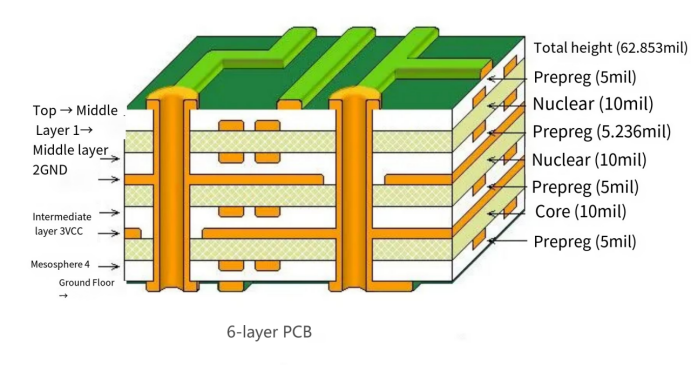

Now, let’s talk about the 6-layer PCB.
A 6-layer PCB is essentially a 4-layer board with the addition of 2 extra signal layers between the planes. The standard stack-up for a 6-layer PCB includes 4 routing layers (two outer layers and two inner layers) and 2 internal planes (one for grounding and the other for power).
Providing 2 internal layers for high-speed signals and 2 external layers for low-speed signals significantly amplifies EMI (Electromagnetic Interference). EMI is the energy that disrupts signals in electronic devices through radiation or induction.
There are various arrangements for the stack-up of a 6-layer PCB, but the number of power, signal, and ground layers used depends on the application requirements.
The standard 6-layer PCB stack-up includes top layer - prepreg - internal ground plane - core - internal routing layer - prepreg - internal routing layer - core - internal power plane - prepreg - bottom layer. As you can see in the picture on the top.
Although this is the standard configuration, it is not suitable for all PCB designs, so it may be necessary to reposition the layers or have additional specific layers. However, routing efficiency and minimizing crosstalk must be considered when placing them.
The advantages of a 6-layer PCB are as follows:
Strength - A six-layer PCB is thicker than its thinner counterparts, making it more robust.
Compactness - This thickness board with six layers has greater technical capabilities, so it can consume less width.
High capacity - PCBs with six or more layers provide optimal power for electronic devices and greatly reduce the likelihood of crosstalk and electromagnetic interference.
The main application areas for 6-layer PCBs are as follows:
Computers - 6-layer PCBs have helped drive the rapid development of personal computers, which have become more compact, lighter, and faster.
Data storage - The high capacity of six-layer PCBs has made data storage devices increasingly abundant over the past decade.
Fire alarm systems - Using 6-layer or more circuit boards, alarm systems have become more precise in the moment of detecting real danger.
In the next article ,we will introduce the high layers PCB, which is totally different form these PCB we have talked before.